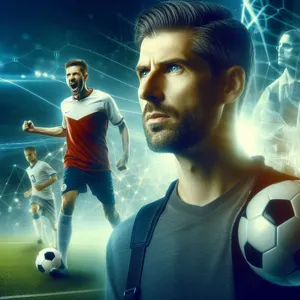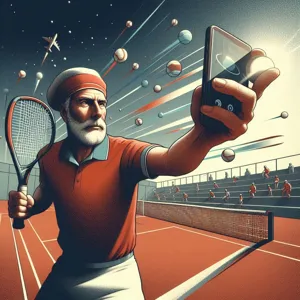In the ever-evolving world of soccer, the transfer market serves as a dynamic stage where fortunes are made and power dynamics shift with every player acquisition and sale.
This annual spectacle not only captivates fans with the thrill of potential new stars joining their favorite clubs but also reflects the intricate chess game of strategy, finances, and ambition that defines the sport. As clubs vie for supremacy, the transfer market becomes a battleground where financial clout, scouting acumen, and negotiation skills are put to the ultimate test. In this blog post, we will delve into how the transfer market reshapes the landscape of soccer, exploring the impact of marquee signings, the rise of smaller clubs challenging traditional powerhouses, and the strategic maneuvers that can alter a team’s trajectory. Join us as we uncover the fascinating interplay between player movements and the shifting sands of power within the beautiful game.
1. Introduction to Power Dynamics in Soccer

In the ever-evolving world of soccer, power dynamics are in a constant state of flux, influenced heavily by the transfer market. Traditionally dominated by a select few elite clubs, the landscape of power is reshaped every season as players move, clubs invest, and new strategies emerge. This transfer market serves not just as a mechanism for player transactions but also as a battleground for clubs vying for supremacy, leveraging their financial clout, scouting prowess, and brand allure to attract top talent.
The introduction of Financial Fair Play regulations has added another layer of complexity to these dynamics, compelling clubs to operate within their means while still striving to assemble competitive squads. As a result, we witness a fascinating interplay where historically powerful teams seek to maintain their dominance against an increasing number of ambitious rivals eager to disrupt the status quo.
Moreover, the rise of data analytics and scouting networks has leveled the playing field, allowing smaller clubs to identify and recruit undervalued talent from around the globe. This democratization of player acquisition means that even those clubs without the financial muscle of the traditional giants can make significant strides, leading to shifts in league standings and unexpected upsets on the pitch.
As we delve deeper into the intricate web of the transfer market and its implications on power dynamics in soccer, we uncover stories of clubs that have risen from obscurity to challenge established norms, and players whose moves have sparked revolutions or reinforced traditional hierarchies. With each transfer window, the stage is set for new alliances, rivalries, and the perennial quest for glory, making the transfer market a vital lens through which to understand the current state of soccer.
2. The Role of the Transfer Market in Shaping Teams
The transfer market is more than just a seasonal event in the world of soccer; it plays a pivotal role in shaping the very fabric of teams and their strategies. Each transfer window brings with it a whirlwind of speculation, negotiation, and ultimately, transformation. Clubs are not merely looking to fill gaps in their squads; they are actively crafting their identities, seeking to balance youth with experience, flair with discipline, and local talent with international stars.
At its core, the transfer market serves as a powerful equalizer in the sport. Historically dominant teams must continuously adapt to the ever-changing landscape, while underdogs seize opportunities to recruit players that can elevate them to new heights. For example, a mid-tier club that secures a promising young talent from a top academy can shift the balance of power, leading to unexpected victories and a surge in fan support. Clubs like Leicester City have shown that with astute signings, they can challenge the traditional powerhouses, proving that the right players can rewrite the narrative of a season.
Moreover, the transfer market influences team dynamics far beyond just the players on the pitch. It affects coaching strategies, as managers must adjust their tactics to accommodate new arrivals or departing stars. The influx of fresh talent can invigorate a squad, raising competition levels and fostering an environment where players are pushed to excel. Conversely, the loss of a key player can lead to a sense of urgency and necessitate a shift in playing style.
Financial considerations also play a critical role in shaping teams through the transfer market. Clubs with deeper pockets often dominate headlines, attracting big-name players and commanding higher salaries. However, smart scouting and strategic investment can enable smaller clubs to thrive, showcasing the ingenuity of management in an otherwise lopsided financial landscape.
Ultimately, the transfer market is a reflection of ambition, strategy, and the relentless pursuit of success. As clubs navigate this complex ecosystem, they must remain agile, always poised to seize the right opportunities that will redefine their paths and reshape the competitive dynamics of soccer. The moves made during these windows can set the stage for triumphs, rivalries, and the unfolding stories that captivate fans around the globe.
3. Historical Perspective: Transfer Market Trends Over the Decades

Understanding the current landscape of the transfer market requires a dive into its historical evolution, revealing how power dynamics in soccer have shifted over the decades. The transfer market has not always been the fast-paced, high-stakes environment we know today. In the early days of football, player transfers were often informal, with clubs relying on verbal agreements and local connections rather than structured contracts.
The 1970s marked a significant turning point, as the introduction of the Bosman ruling in 1995 transformed player mobility and contract negotiations. This landmark decision allowed players in the European Union to transfer to another club at the end of their contract without a transfer fee, empowering athletes and reshaping the dynamics between clubs and players. As a result, we saw the rise of player power, with star athletes leveraging their status to negotiate better salaries and conditions.
The 2000s brought about an era of unprecedented financial investment from clubs, particularly in Europe’s top leagues. The influx of television revenue and sponsorship deals led to inflated transfer fees and wages, allowing clubs to attract top talent from around the globe. This shift intensified competition, as clubs scrambled to secure marquee signings to enhance their chances of success, thereby altering the traditional hierarchy within leagues.
In recent years, we’ve witnessed the emergence of mega-clubs like Manchester City and Paris Saint-Germain, backed by wealthy owners willing to invest heavily in their squads. This has created a bifurcation within the sport, where a handful of clubs dominate the transfer market while others struggle to keep pace. The influence of social media and digital platforms has further played a role, amplifying transfer rumors and speculation, creating a frenzy around player movements that can shift the perceived power balance overnight.
As we examine these historical trends, it becomes clear that the transfer market is not merely a transactional process but a complex interplay of economics, power, and ambition that continues to redefine the landscape of soccer. Understanding this evolution is crucial for fans and stakeholders alike, as it sheds light on why certain clubs rise to prominence while others languish in the shadows. The shifting sands of the transfer market will undoubtedly continue to impact the beautiful game in ways we can only begin to imagine.
4. Financial Influence: The Impact of Wealthy Clubs on Competition
In the ever-evolving landscape of soccer, the financial prowess of wealthy clubs has emerged as a pivotal force reshaping competitive dynamics. Gone are the days when a club’s success was solely reliant on its historical legacy or local talent development; today, the transfer market serves as a high-stakes arena where money talks louder than ever.
Clubs like Manchester City, Paris Saint-Germain, and Chelsea have turned the transfer market into their playground, leveraging substantial financial backing to attract top-tier talent from around the globe. With vast resources at their disposal, these teams can outbid rivals for star players, secure lucrative sponsorship deals, and invest in state-of-the-art facilities. This influx of capital not only enhances their on-field performance but also significantly alters the balance of power within leagues and competitions.
As a result, traditional powerhouses that once dominated European football are now grappling with the challenge of maintaining their status in a landscape increasingly dictated by financial muscle. Clubs that have historically relied on their academy systems or local talent find themselves at a disadvantage, struggling to keep pace with the spending capabilities of wealthier rivals. The once level playing field is shifting, creating a growing divide between the haves and have-nots.
Moreover, this financial influence extends beyond individual clubs; it impacts the entire ecosystem of soccer. Lower-tier teams often face the harsh reality of being picked clean by richer clubs eager to bolster their squads, leading to a talent drain that can stifle competitiveness in domestic leagues. This phenomenon raises questions about the sustainability of such a system, where financial might overshadows skill and strategy.
In essence, the transfer market has become a litmus test for the evolution of soccer’s competitive landscape. As clubs vie for supremacy, the influence of wealth will undoubtedly continue to redefine not just who wins on the pitch, but also the very essence of what it means to be competitive in the beautiful game. The divide between rich and poor clubs may widen, but as fans, we are left to ponder: can the spirit of competition endure in an era where financial influence reigns supreme?
5. High-Profile Transfers: Case Studies of Game-Changing Moves

In the ever-evolving landscape of soccer, high-profile transfers have become pivotal events that not only reshape teams but also redefine the power dynamics within the sport. These moves, often accompanied by hefty price tags and extensive media coverage, echo far beyond the pitch, influencing fan engagement, merchandising, and even the strategies of rival clubs.
One of the most notable examples is the transfer of Neymar from Barcelona to Paris Saint-Germain in 2017. This record-breaking move, valued at a staggering €222 million, sent shockwaves throughout the soccer world. PSG’s acquisition of Neymar was not just about securing a talented forward; it was a bold statement of intent. The club aimed to position itself as a dominant force in European soccer, challenging the traditional powerhouses. Neymar’s arrival drew global attention, significantly increasing PSG’s marketability and fanbase across continents, thereby altering the competitive landscape in Ligue 1 and beyond.
Another game-changing transfer was Cristiano Ronaldo’s move to Juventus in 2018. The Portuguese superstar, who had established himself as one of the greatest players of all time during his tenure at Real Madrid, made headlines once again as he signed with the Italian giants. This transfer was not purely about on-field performance; it was also a strategic play for Juventus. By bringing in Ronaldo, the club sought to reclaim its status as a dominant force in Serie A and elevate its profile in the Champions League. Ronaldo’s presence not only boosted ticket sales and merchandise revenue but also significantly enhanced the club’s global visibility, attracting sponsorships and partnerships that had previously eluded them.
These high-profile transfers illustrate how individual moves can alter the trajectories of clubs, inspiring them to invest further in talent and infrastructure. They also highlight the intricate relationship between player movements and broader trends in soccer economics. As clubs vie for supremacy, these monumental decisions continue to shape the competitive landscape, reinforcing the notion that the transfer market is as much about strategy and ambition as it is about talent.
As we delve deeper into the shifting sands of soccer’s power dynamics, it becomes clear that each high-profile transfer is not just a transaction; it’s a catalyst for change, redefining the very essence of competition in the beautiful game.
6. Youth Academies and Their Effect on Power Structures
In the ever-evolving landscape of soccer, youth academies have emerged as pivotal players in shaping the power dynamics within the sport. Traditionally, the narrative revolved around established clubs with deep pockets acquiring the best talent from around the globe. However, the rise of youth academies is changing the game, allowing clubs to cultivate their own talent from a young age, thereby altering the balance of power.
Clubs like Barcelona, Ajax, and Manchester United have long recognized the potential of nurturing young players through their academies, investing heavily in infrastructure and coaching staff. These academies not only serve as a breeding ground for future stars but also as a strategic tool that can strengthen a club’s financial standing. When a homegrown talent breaks into the first team, the return on investment can be enormous. Clubs can either reap the benefits of having a world-class player on their roster or leverage that talent in the transfer market for a substantial fee.
Moreover, the emergence of successful youth academies has leveled the playing field, allowing smaller or less wealthy clubs to compete more effectively against their larger counterparts. A club with a strong academy can attract attention and investment, even if they lack the financial muscle to sign established superstars. This shift encourages clubs to prioritize youth development, fostering a culture where homegrown players are valued and celebrated.
Additionally, the impact of youth academies extends beyond individual clubs; it has a ripple effect on national teams. Countries that invest in their youth systems often see a more robust performance on the international stage, as teams are filled with players who have been trained in a consistent environment, emphasizing core values and technical skills from a young age.
As the landscape of soccer continues to change, the significance of youth academies cannot be overstated. They represent a shift in strategy, power, and identity within the sport, where nurturing talent is just as valuable—if not more so—than splurging on marquee signings. Clubs that effectively harness this potential will not only redefine their own futures but also contribute to the broader evolution of soccer as a whole.
7. The Rise of Mid-Tier Clubs Through Strategic Transfers

In the ever-evolving landscape of soccer, the transfer market is not just a battleground for the elite; it has become a vital arena for mid-tier clubs to carve out their place in the hierarchy of the sport. Historically overshadowed by the giants, these clubs are now leveraging strategic transfers to not only enhance their competitive edge but also to redefine the power dynamics within their leagues.
Mid-tier clubs are increasingly becoming savvy operators in the transfer market, identifying undervalued talent and emerging players who possess the potential to shine on bigger stages. By scouting internationally and tapping into lesser-known leagues, these clubs can secure players who may have slipped under the radar of larger teams, thus creating a unique blend of talent that can challenge the established order.
Moreover, the rise of data analytics has transformed how these clubs assess player potential and performance. By utilizing advanced metrics and scouting tools, mid-tier teams can make informed decisions that maximize their limited budgets. This approach not only bolsters their squads but also increases their chances of achieving coveted positions in league standings and qualifying for European competitions.
For instance, clubs that once relied on being mere stepping stones for talented players are now establishing their own identity and brand in the footballing world. They are nurturing young prospects and giving them the platform to develop, often resulting in a lucrative transfer profit when these players eventually move to larger clubs. This cycle not only financially empowers the mid-tier clubs but also enhances their reputation as breeding grounds for talent.
As these mid-tier teams continue to make shrewd acquisitions and become more competitive, the traditional power structures in soccer are being challenged. The rise of clubs outside the established elite signals a shift in the narrative; it’s no longer just about which club has the deepest pockets but also about who can best utilize the resources at their disposal. As the transfer market grows ever more unpredictable, the smart investments of mid-tier clubs will undoubtedly play a crucial role in shaping the future of the sport.
8. The Impact of Player Agents on Transfer Negotiations
In the intricate world of soccer transfer negotiations, player agents have emerged as pivotal figures, wielding significant influence over the dynamics of player movement and club strategies. These intermediaries, often seen as power brokers between clubs and athletes, play a crucial role in shaping the landscape of transfers by leveraging their extensive networks, negotiating skills, and market knowledge.
Player agents are not just representatives; they are strategic architects of a player’s career. Their expertise extends beyond simple contract negotiations; they analyze market trends, assess a player’s value, and position them in a way that maximizes both their visibility and marketability. In doing so, they can sway clubs to offer lucrative deals, ensuring that their clients receive the best possible financial terms and playing opportunities.
Moreover, agents often hold the keys to a player’s future, influencing decisions on transfers, contract renewals, and even club loyalties. A well-connected agent can create bidding wars among clubs, driving up transfer fees and salaries while simultaneously enhancing a player’s bargaining power. This can lead to a significant shift in the balance of power within the league, as clubs with strong agent relationships may gain an edge in attracting top talent.
However, the growing influence of player agents also raises questions about the integrity of the transfer market. Concerns around transparency and conflicts of interest have led to calls for regulation, as agents sometimes prioritize their own financial gain over a player’s best interests. The delicate dance between clubs, agents, and players creates a complex web that can either uphold or undermine the values of fair play and loyalty in soccer.
As the transfer market continues to evolve, the impact of player agents will undoubtedly reshape the power dynamics within the sport. Their ability to navigate the ever-changing landscape of soccer not only affects individual players but also has broader implications for clubs, leagues, and the very fabric of the beautiful game. In this shifting sands environment, understanding the role of player agents is essential for anyone looking to grasp the true nature of modern soccer’s transfer market.
9. Domestic vs. International Transfers: Shifting Focus
In recent years, the landscape of soccer transfers has undergone a significant transformation, reflecting broader trends in the sport’s global economy. The traditional focus on domestic transfers—where clubs primarily buy and sell players within their own leagues—has begun to shift, creating a more complex interplay between domestic and international movements.
Clubs are now looking beyond their borders for talent, driven by the pursuit of exceptional players who can bring unique skills and perspectives to their teams. International transfers have become a hotbed of activity, with clubs from diverse leagues scouting talent in regions previously overlooked. For example, the rise of African and South American leagues has opened up pathways for clubs to discover hidden gems that can elevate their squads without breaking the bank.
This shift has also been influenced by the increasing globalization of soccer, where players from all corners of the globe are showcasing their talents on the world stage. The success of international tournaments such as the World Cup and continental championships has heightened the visibility of players from non-traditional soccer powerhouses. As a result, clubs are more willing to invest in international talents, believing that the potential return on investment—both on the pitch and in terms of merchandise sales and global fan engagement—can far outweigh the risks.
Moreover, the competitive nature of the transfer market has compelled clubs to rethink their strategies. While signing star players from rival domestic teams can create headlines, there’s a growing realization that scouting talent from international markets can provide a more sustainable and cost-effective approach. This has led to the establishment of scouting networks and partnerships with clubs abroad, allowing teams to tap into a wealth of talent that was previously inaccessible.
As the lines between domestic and international transfers continue to blur, clubs must adapt to the evolving dynamics of the market. Understanding the nuances of different leagues, cultural contexts, and player backgrounds is essential for success in this new era. The power dynamics within soccer are shifting, and those clubs that can adeptly navigate this landscape will be best positioned to thrive in a fiercely competitive environment. The game is changing, and the transfer market is at the heart of this evolution.
10. Technology and Data Analytics in Transfer Decisions
In the fast-evolving landscape of soccer, technology and data analytics have emerged as game-changers, redefining how clubs approach the transfer market. Gone are the days when intuition and anecdotal evidence were the primary tools for scouting talent. Today, clubs are harnessing sophisticated algorithms and comprehensive data sets to make informed transfer decisions that can significantly impact their success on the pitch.
At the heart of this transformation is the explosion of performance metrics. Player statistics now extend far beyond basic goals and assists; they include intricate details like expected goals (xG), pass completion rates, and defensive actions. This wealth of information allows clubs to evaluate potential signings with a precision that was previously unattainable. For instance, a player’s ability to create chances from various positions on the field can be quantified, enabling scouts to identify hidden gems who might be overlooked by traditional scouting methods.
Moreover, technology has revolutionized the scouting process itself. Advanced video analysis tools allow clubs to analyze match footage from across the globe, providing insights into a player’s skill set, decision-making, and adaptability in different game scenarios. Virtual reality (VR) and augmented reality (AR) are also becoming increasingly popular, allowing coaches and scouts to simulate in-game situations and assess how a player responds under pressure.
Data analytics also plays a pivotal role in injury prevention and player fitness assessments. By analyzing a player’s physical load and biometric data, clubs can make smarter decisions regarding transfers, ensuring they invest in athletes who not only have the talent but also the physical resilience required for a demanding season. This focus on player welfare ultimately leads to a more sustainable investment, reducing the likelihood of costly injuries that could sideline key signings.
As the transfer market becomes more competitive, clubs that embrace technology and data analytics will have a distinct advantage. By leveraging these tools, they can make smarter decisions that not only strengthen their squads but also reshape power dynamics within the league. In this new era of soccer, the successful integration of tech-driven insights into transfer strategies could very well determine which teams rise to the top and which ones fall behind in the relentless pursuit of glory.
11. The Influence of Fan Engagement and Marketability
In the rapidly evolving landscape of soccer, the influence of fan engagement and marketability has emerged as a pivotal factor in the transfer market, reshaping the power dynamics that historically defined the sport. As clubs vie for supremacy, it is no longer just about securing the best talent on the pitch; it’s equally about cultivating a brand that resonates deeply with fans, both locally and globally.
Today’s soccer fans are more than mere spectators; they are active participants in the narrative of their favorite clubs. This shift has prompted teams to prioritize not just the acquisition of star players but also those who can bolster their marketability and engagement strategies. A player’s social media following, community involvement, and overall charisma can significantly impact merchandise sales and fan loyalty, shifting the balance of power towards those clubs that understand and harness this engagement effectively.
Clubs like Manchester City and Paris Saint-Germain have demonstrated how powerful a well-marketed player can be. These teams have not only invested in top-tier talent but have also strategically signed players whose personal brands can amplify the club’s global reach. The result? A surge in merchandise sales, increased sponsorship deals, and a loyal fan base that feels personally connected to their heroes.
Moreover, engaging fans through innovative content, exclusive behind-the-scenes access, and interactive experiences has become crucial. Clubs that excel in these areas are able to foster a sense of community, making their supporters feel integral to the club’s success. This deeper connection translates into greater commitment, whether in terms of attendance at matches, participation in club events, or engagement with digital content.
In this new era, the transfer market is not solely about athletic prowess; it is a complex interplay of talent, marketability, and fan engagement. Clubs that recognize and adapt to this reality will not only navigate the shifting sands of power dynamics but thrive within them, continually attracting both top players and devoted fans alike.
12. Consequences of a Volatile Transfer Market
The transfer market in soccer has become a double-edged sword, wielding the power to uplift clubs to new heights or plunge them into disarray. As clubs navigate this ever-changing landscape, the consequences of a volatile transfer market ripple throughout the sport, altering the balance of power in profound ways.
At the heart of this volatility lies the constant fluctuation of player values driven by demand, performance, and market trends. Clubs that either mismanage their resources or fail to adapt can find themselves at a significant disadvantage. For instance, a sudden surge in player prices can lead to financial strain, resulting in clubs either overextending their budgets or missing out on key signings altogether. This imbalance creates a breeding ground for inequality, as wealthier clubs can easily absorb these shocks, snatching up talent and leaving smaller clubs scrambling to keep pace.
Moreover, the emotional toll on fan bases cannot be understated. The excitement of a marquee signing can swiftly turn to despair as key players depart for lucrative offers elsewhere, leaving supporters feeling betrayed and uncertain about their club’s future. This instability can erode the loyalty of even the most devoted fans, who may begin to question their allegiance to a club that seems unable to maintain a consistent identity.
Additionally, the volatility of the transfer market encourages a mentality of short-term thinking among clubs. In the quest for immediate success, clubs might overlook the importance of developing homegrown talent or cultivating a cohesive team ethos. This can lead to a cycle of constant turnover, where clubs are in a perpetual state of rebuilding rather than fostering long-term growth and stability.
In the end, the consequences of a volatile transfer market are multifaceted, influencing not only the clubs directly involved but also the broader landscape of soccer itself. As teams grapple with these challenges, the power dynamics of the sport continue to shift, reminding us that in the world of soccer, change is the only constant.
13. Future Trends: What Lies Ahead for the Transfer Market
As the soccer landscape continues to evolve, the transfer market is set to undergo significant transformations that will redefine power dynamics within the sport. With an increasing emphasis on data analytics, clubs are harnessing advanced technologies to scout talent, assess player potential, and make informed decisions. This shift towards a data-driven approach not only enhances the efficiency of player recruitment but also levels the playing field for smaller clubs that may not have the financial clout of their larger counterparts.
Moreover, the growing influence of social media and digital platforms is changing how players and clubs interact with fans and each other. Transfer news spreads like wildfire, often leading to heightened speculation and pressure on clubs to act swiftly. As fans become more engaged in the transfer process, clubs are recognizing the importance of transparency and communication to maintain loyalty and excitement among their supporter base.
Another emerging trend is the increasing role of player agents in shaping the transfer market. As intermediaries, agents are not just negotiating contracts; they are also playing a pivotal role in influencing player movements and decisions. Their ability to navigate complex negotiations and leverage relationships can significantly impact a club’s success in securing desired talent.
Additionally, the rise of alternative revenue streams, such as merchandise sales and digital content, is allowing clubs to invest more strategically in their squads. This financial flexibility could lead to a more competitive environment, where clubs that once struggled to attract top talent can now make significant investments, further blurring the lines of traditional power dynamics.
As we look to the future, the transfer market will likely become more globalized, with clubs scouting talent from unconventional regions and leagues. This diversification of talent pools will not only enrich the game but also challenge established norms, as clubs adapt to a rapidly changing environment. In this shifting landscape, agility, innovation, and foresight will be the keys to thriving in the transfer market and redefining the power dynamics that have long dominated the beautiful game.
14. Conclusion: The Evolving Landscape of Soccer Power Dynamics
As we draw this exploration of the transfer market’s impact on soccer power dynamics to a close, it becomes clear that the landscape of the sport is in a constant state of flux. Traditionally, power was concentrated in the hands of a few elite clubs, often bolstered by their rich histories and deep financial resources. However, the dynamics have shifted dramatically in recent years, propelled by the influx of investment from both traditional and non-traditional sources.
Clubs once considered mid-tier are now emerging as formidable competitors, harnessing innovative strategies to attract talent and secure sponsorships. The rise of analytics, scouting networks, and a holistic approach to player development has leveled the playing field, allowing smaller clubs to identify and nurture talent that rivals the big names. Additionally, the growing influence of social media and global broadcasting rights means that clubs from lesser-known leagues can reach audiences far beyond their geographic boundaries, expanding their brand and fan base exponentially.
As we look ahead, the transfer market will likely continue to serve as a barometer for power shifts within the sport. Players are more than just commodities—they are influencers, and their movements can dictate market trends and fan engagement. The emergence of new powerhouses, often driven by forward-thinking management and strategic investments, challenges the status quo and encourages a more competitive and unpredictable environment.
In this evolving landscape, clubs must not only invest in star players but also focus on creating sustainable models that prioritize long-term success. The notion of “power” in soccer is no longer solely defined by the size of a club’s trophy cabinet; rather, it encompasses a broader spectrum of influence, innovation, and adaptability. As the transfer market continues to evolve, one thing is certain: the beautiful game will remain as dynamic and captivating as ever, with new stories of triumph and rivalry unfolding each season.
15. Call to Action: Engaging Fans in the Discussion on Transfer Market Effects
As the dust settles on another whirlwind transfer window, the effects on clubs, players, and fans alike continue to ripple through the soccer landscape. Now, it’s your turn to join the conversation! We invite you to share your thoughts and insights about how the transfer market is reshaping the power dynamics in the sport. Are you a fan of your club’s latest signing, or do you feel the club missed an opportunity?
Engagement is key; whether it’s through social media platforms, fan forums, or dedicated discussion threads, your voice matters. What strategies do you think clubs should adopt to navigate the volatility of the transfer market? How do you feel about the influence of financial powerhouses overshadowing traditional giants?
We encourage you to dive into discussions, share your opinions, and connect with fellow fans. Use the hashtag #TransferTalk to make your thoughts heard and become part of a growing community excited about the future of soccer. Your insights could spark debates and drive awareness around the crucial role the transfer market plays in the beautiful game.
Moreover, consider participating in our upcoming live Q&A sessions, where industry experts and soccer analysts will dissect recent transfer trends and their implications for clubs and competitions worldwide. Together, let’s explore how the shifting sands of the transfer market can redefine not just the teams we support, but the very essence of soccer itself. Don’t just watch the game—be part of the discussion!
As we conclude our exploration of the transfer market and its profound impact on the power dynamics within soccer, it becomes clear that the landscape of the game is ever-changing. The shifting sands of player movements, financial investments, and strategic decisions by clubs not only reshape team capabilities but also redefine the competitive balance across leagues and nations. From the rise of once-underdog teams to the consolidation of power among elite clubs, the transfer market serves as a barometer for ambition, strategy, and innovation in the sport. As fans, we must stay attuned to these developments, for they not only influence the teams we support but also the broader narrative of soccer itself. The next transfer window is sure to bring new surprises and shifts, and we can only anticipate how these changes will continue to evolve the beautiful game. Thank you for joining us on this journey through the intricate world of soccer’s transfer market—stay tuned for more insights and analysis as we follow the ever-unfolding story of this dynamic sport.




































